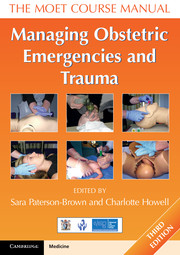Book contents
- Frontmatter
- Dedication
- Contents
- Working Group
- About the authors
- Acknowledgements
- Abbreviations
- Section 1 Introduction
- Section 2 Recognition
- Section 3 Resuscitation
- Section 4 Trauma
- Section 5 Other medical and surgical emergencies
- Section 6 Obstetric emergencies
- 24 Pre-eclampsia and eclampsia
- 25 Major obstetric haemorrhage
- 26 Caesarean section
- 27 Placenta accreta and retained placenta
- 28 Uterine inversion
- 29 Ruptured uterus
- 30 Ventouse and forceps delivery
- 31 Shoulder dystocia
- 32 Umbilical cord prolapse
- 33 Face presentation
- 34 Breech delivery and external cephalic version
- 35 Twin pregnancy
- 36 Complex perineal and anal sphincter trauma
- 37 Symphysiotomy and destructive procedures
- 38 Anaesthetic complications in obstetrics
- Section 7 Triage and transfer
- Section 8 Human issues
- Index
25 - Major obstetric haemorrhage
- Frontmatter
- Dedication
- Contents
- Working Group
- About the authors
- Acknowledgements
- Abbreviations
- Section 1 Introduction
- Section 2 Recognition
- Section 3 Resuscitation
- Section 4 Trauma
- Section 5 Other medical and surgical emergencies
- Section 6 Obstetric emergencies
- 24 Pre-eclampsia and eclampsia
- 25 Major obstetric haemorrhage
- 26 Caesarean section
- 27 Placenta accreta and retained placenta
- 28 Uterine inversion
- 29 Ruptured uterus
- 30 Ventouse and forceps delivery
- 31 Shoulder dystocia
- 32 Umbilical cord prolapse
- 33 Face presentation
- 34 Breech delivery and external cephalic version
- 35 Twin pregnancy
- 36 Complex perineal and anal sphincter trauma
- 37 Symphysiotomy and destructive procedures
- 38 Anaesthetic complications in obstetrics
- Section 7 Triage and transfer
- Section 8 Human issues
- Index
Summary
Objectives
On successfully completing this topic, you will be able to:
understand the definition and causes of major obstetric haemorrhage
recognise and manage maternal collapse caused by obstetric haemorrhage
understand the pharmacological and surgical options for the treatment of major obstetric haemorrhage
make a plan to facilitate optimum management in your environment
understand the concerns to be discussed with a woman declining blood and blood products during pregnancy.
Introduction
Major haemorrhage remains a leading cause of maternal mortality despite modern improvements in obstetric practice and transfusion services. In addition, all ‘near miss’ audits, in deve loped as well as developing countries, show major haemorrhage to be one of the leading causes of severe maternal morbidity.
Complications of haemorrhage associated with first-trimester bleeding due to miscarriage or ectopic pregnancy are not within the remit of the MOET course, although most general principles will apply.
Maternal mortality and incidence of major haemorrhage
The CMACE Confidential Enquiry into maternal deaths 2006 to 2008 showed a welcome reduction in deaths due to postpartum haemorrhage. However, despite a halving in the number of such deaths since the previous triennial report, obstetric haemorrhage remains a source of concern in the UK, with evidence of substandard care in three out of the five cases. In particular, a lack of routine observations in the postpartum period and failure to appreciate that significant (concealed) bleeding was occurring led to a lack of appropriate action including no early senior involvement. The report restates previous comments that all units should have procedures in place for the identification and management of major obstetric haemorrhage, and that regular skills training sessions should take place.
- Type
- Chapter
- Information
- Managing Obstetric Emergencies and TraumaThe MOET Course Manual, pp. 297 - 312Publisher: Cambridge University PressPrint publication year: 2014

